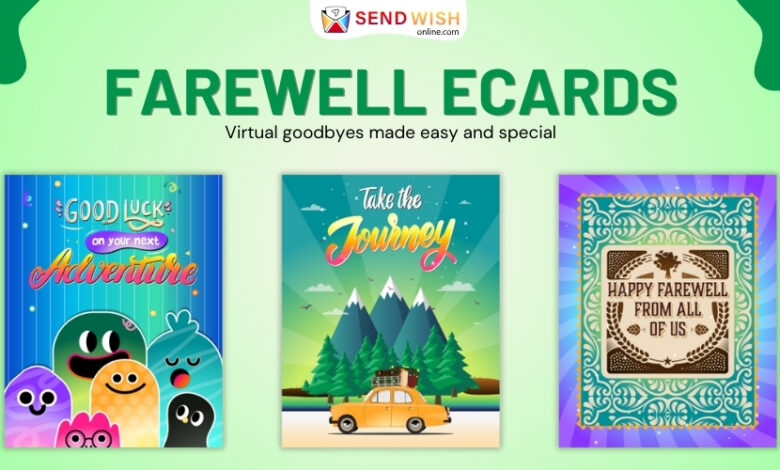A Touch of Personalization: Designing a Sincere Goodbye Card

Goodbyes are often bittersweet, filled with emotions as someone embarks on a new chapter in their life. Whether it’s a colleague moving on to a new job, a friend relocating to another city, or a loved one transitioning to a different phase of life, a thoughtful and sincere goodbye card captures these sentiments beautifully. A well-crafted card can serve as a meaningful keepsake, marking shared memories, gratitude, and good wishes for the future. This article will guide you through designing a heartfelt goodbye card that leaves a lasting impression.
The Importance of a Goodbye Card
A goodbye card is more than just a formality; it’s a heartfelt gesture that expresses appreciation, fond memories, and well wishes. In today’s digital age, a physical card can stand out and carry significant emotional weight. A well-written goodbye card can:
- Reinforce Relationships: A goodbye card allows you to express the impact someone has had on your life. It strengthens the bond by acknowledging the value of the relationship.
- Provide Closure: Writing or receiving a goodbye card can help both parties find closure, enabling them to move forward with positive emotions.
- Create a Keepsake: A thoughtful card is often kept as a cherished memento, serving as a reminder of the shared experiences and connection.
- Communicate Difficult Emotions: Saying goodbye in person can be emotionally challenging. A card allows you to express feelings that may be hard to articulate face-to-face.
Designing Your Goodbye Card
Before you start creating your goodbye card, it’s important to consider both the message and the design. A little extra thought and personalization can make the card more meaningful. Here’s how to start:
- Know the Recipient’s Preferences Take into account the recipient’s personality, interests, and preferences. Personalizing the card based on their likes will make it more special.
- Formal vs. Casual: For colleagues or acquaintances, a more formal tone may be appropriate. For close friends or family, feel free to use a casual or playful tone.
- Hobbies and Interests: If the recipient has specific hobbies or interests, incorporate them into the design. For example, if they love traveling, a travel-themed card would be fitting.
- Choose the Right Medium Decide whether you want to create a physical or digital card. Each medium has its benefits:
- Physical Cards: These can be handmade or store-bought and allow for a personal, tactile experience. Handmade cards, in particular, show an extra level of effort.
- Digital Cards: These are convenient, especially for long-distance recipients, and offer more creative options like animations and music.
- Select a Theme The theme of your card should align with the occasion and the recipient’s personality. Here are a few common themes:
- Nostalgia: Focus on shared memories and experiences. Include photos, inside jokes, or significant moments.
- Adventure: Highlight the recipient’s exciting journey ahead. Use language that emphasizes new beginnings.
- Sentimentality: Opt for heartfelt messages and soft, emotional design elements like gentle colors and warm language.
- Humor: If appropriate, lighten the mood with humor through witty quotes or playful imagery.
Writing the Message
The heart of a goodbye card is the message itself. Here’s a guide on how to write a memorable and meaningful farewell:
- Start with a Warm Greeting Open your card with a friendly and personal greeting.
- Example: “Dear [Recipient’s Name],” or “To my amazing friend [Recipient’s Name],”
- Express Gratitude Take a moment to acknowledge and appreciate the recipient’s role in your life.
- Example: “I’m so grateful for all the memories we’ve shared, especially…”
- Example: “Thank you for being such a wonderful [friend/colleague]. Your [kindness/support] made a world of difference.”
- Share Fond Memories Recall specific shared experiences that have made your relationship special.
- Example: “I’ll never forget the time we [specific memory]. Those moments will always hold a special place in my heart.”
- Example: “We’ve shared so many laughs, like when we…”
- Wish Them Well Offer your best wishes for the recipient’s future. Whether they’re starting a new job, moving to a new city, or embarking on a new adventure, words of encouragement are always appreciated.
- Example: “I know you’ll do great in [new city/job]. Wishing you all the success and happiness in this next chapter.”
- Example: “Here’s to your next adventure! May it bring you as much joy as you’ve brought into our lives.”
- Add a Personal Touch Make the card extra special by including a personal note, an inside joke, or a shared quote.
- Example: “Don’t forget our [inside joke]. Let’s keep it going, even from a distance!”
- Example: “As [shared quote] says, ‘[Quote],’ I’ll always remember our times together.”
- Sign Off with Love Close your card with a warm and thoughtful sign-off.
- Example: “With love and best wishes,” or “Till we meet again,”
Adding Creative Elements
Enhance the visual appeal of your card with these creative elements:
- Photos or Illustrations
- Photo Collage: A collage of shared moments can add a personal touch.
- Illustrations: If you’re artistically inclined, consider adding illustrations that reflect the theme of the card.
- Handwritten Notes Handwritten notes add a personal touch that can’t be replicated by digital fonts. Even if it’s a digital card, you can scan and upload a handwritten message.
- Decorative Elements
- Stickers and Washi Tape: Add some flair to your card with colorful decorations.
- Pressed Flowers: Pressed flowers add a delicate, natural element to physical cards.
- Color and Font Choices Choose colors and fonts that match the tone of your card. Soft colors for sentimental cards or bold colors for humorous ones can set the right mood.
- Interactive Elements For digital cards, consider adding a QR code or link to a shared playlist, video message, or photo album to make the card interactive and engaging.
Personalizing Based on Relationships
The tone and message of your goodbye card should reflect your relationship with the recipient. Here’s how to tailor your card based on different relationships:
- For a Colleague
- Professional Achievements: Acknowledge their contributions and successes at work.
- Express Gratitude: Thank them for their support and collaboration.
- Offer Continued Support: Mention staying connected through professional platforms like LinkedIn.
- For a Friend
- Shared Experiences: Highlight inside jokes and fun times.
- Express Emotion: Don’t hesitate to share how much their friendship means to you.
- Stay Connected: Reassure them that distance won’t change your bond.
Conclusion
Designing a sincere goodbye card requires thought, creativity, and a personal touch. By carefully selecting the message, design elements, and themes, you can create a meaningful keepsake that the recipient will cherish. Whether it’s a colleague, friend, or loved one, a heartfelt farewell card is a wonderful way to celebrate shared memories and offer warm wishes for the future.



